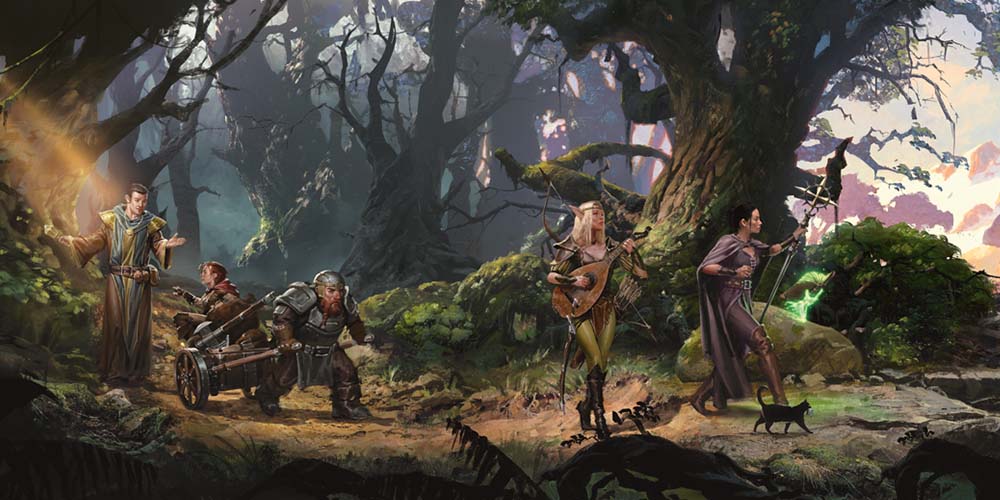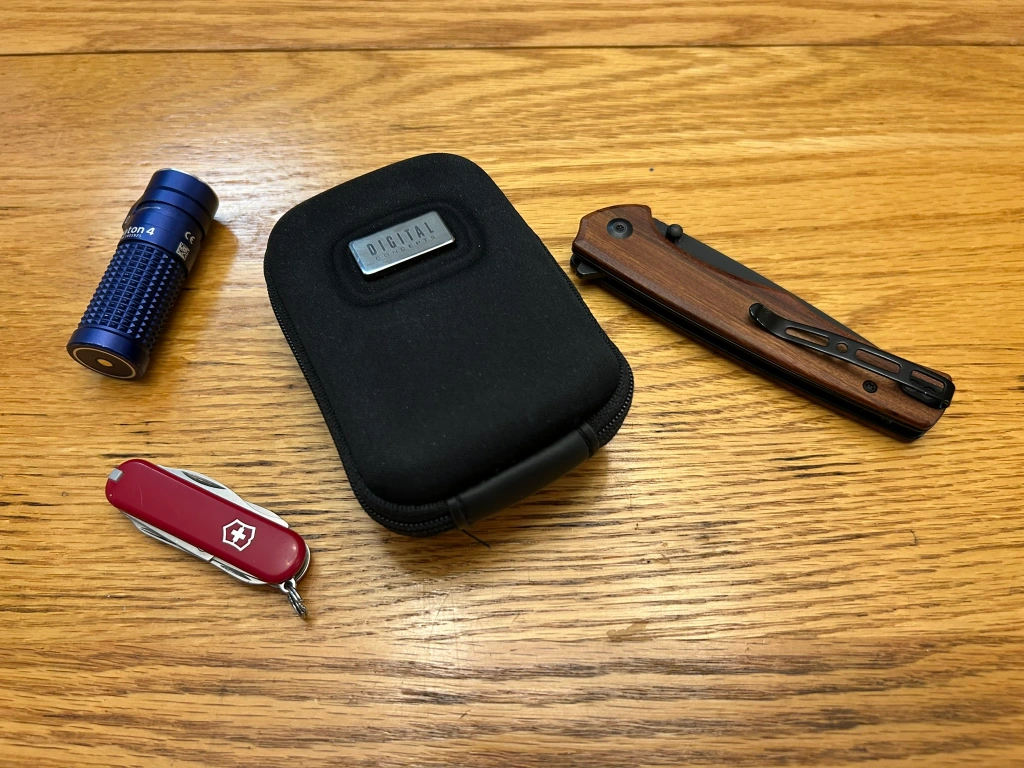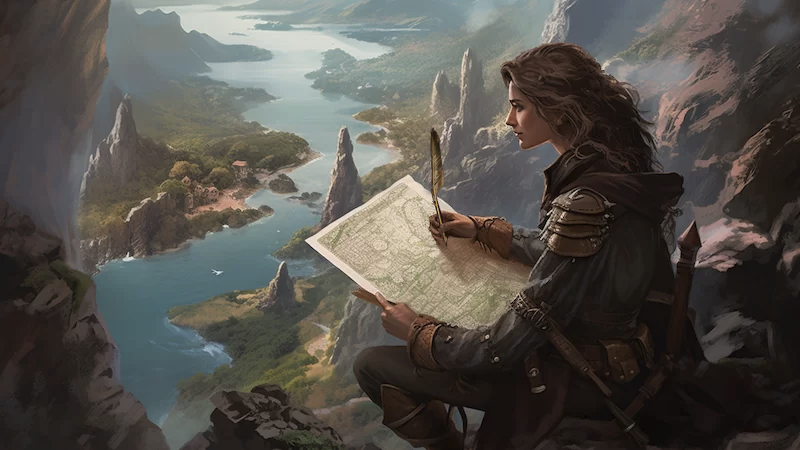If you want to track some travel in your fantasy RPG, consider this advice: don’t roll for random terrain. There are systems for this, and it makes a certain amount of sense at the 3-mile hex level, but a pure hex crawl thru random terrain is rarely satisfying.
Wandering is great if you’re wandering a prepared world, but wandering a completely random world is just going to feel random. Instead, draw out your realm and put a 6-mile hex grid on the part the heroes will adventure in, and use it to decide on the realms and terrain. Make your own decisions about where there will be cities and rivers and ruins.
Per my mapping post, it’s easiest and most realistic to start with an old map of a real place and modify to the coastlines to be unrecognizable. Then you’ll know where mountains, rivers, and cities should be. Just remember that a lot of it should still be wilderness.
Daylight & Weather
First, decide what time of year it is and where your heroes are traveling. This will tell you how many hours of daylight they have, etc. Traveling at night is possible with torches or magic but should be more dangerous, since many monsters are night hunters (not to mention exhausting).
This isn’t crucial, but it helps avoid every adventure happening on a pleasant day in May, especially if you use my simple-but-realistic weather system.
Travel Time
Ordinary people (and horses) can only walk for 7 or 8 hours a day before becoming exhausted, even with occasional rests. So the amount of daylight is less relevant than the terrain. You may want to use my difficult terrain navigation rules.
The heroes have 18 points to spend on travel every day, depending on the terrain. They can push themselves to get a few extra points, but they’ll tire out, thereby constantly -1 hp per level until they get a good night’s rest. If they have a couple of points left over, they can apply them to the next day (in reality, they got part-way across an extra hex that day).
If the players want details, say they can travel 6 hours and rest for 1 or 2 hours over the course of the day without getting overtired. Traveling an extra hour gives them 3 more points and costs 1 hp per level.
| Terrain | Cost per 6-mi Hex | Cost per 3-mi Hex |
|---|---|---|
| Good road, woodland trail, grassland | 6 | 3 |
| Poor or hilly road, moor | 8 | 4 |
| Forest, hills | 12 | 6 |
| Dense or hilly forest, marsh, mountain trail | 16 | 8 |
| Mountains, swamp | 18 | 9 |
Finding Points of Interest
Generally, in a 6-mile hex, the heroes should find major points of interest, like a town or a ruin on hill, when they enter the hex. (Such things tend to be next to roads.) But things that are actually hidden–like the entrance to a cave–must be found by directions or a guide.
The heroes can most easily find these points of interest by asking around in towns and cities. The locals–especially shepherds–know the environs like the back of their hands, so asking for guidance is much more practical than literally wandering around.
On a 6-mile hex map, there would be–in settled lands–a town every one or two hexes, so these would be too numerous to map. Instead, keep a list of towns by name and standout feature and populate them with NPCs only if the heroes stop at them (keep a list of NPC names handy). There should be a city every three or four hexes, connected by roads, each with at least one sage.
There should be other points of interest (ruins and such) every six to eight hexes, especially outside settled lands. You might create a list of these by name and nature and use them to populate your map. You can get a start with my list of fantasy world points of interest and my killer encounter settings.
Low-level Hex Crawls
For low-level adventurers, it makes some sense to create a map with a city, a couple of towns, and a lot of wilderness at a scale of 3- or even 1-mile hexes. The heroes can venture out from town to a ruins or monster lair they’ve heard about, have their adventure, and return to town.
After a couple of these, they can go to the city and hear about points of interest around there. A 1-mile hex map could keep the heroes happy right up thru 4th level.

There are two ways to manage this, and you can use both.
The first way is to map the ruins and monster lairs that are known to the locals. The players can simply travel right to them, altho there should be a chance of getting lost.
The second way is to not map ruins and monster lairs you consider secret. You can then use a dice chain countdown timer to determine when the heroes find one of the secret locations. Start with a d20 when the heroes get away from town and into the wilderness. When they enter a new hex, roll a d12. And so on, until you roll a 1, determining they’ve found something. You can then decide or roll on your own table to determine what it is. In the meantime, you can give them terrain trouble and innocuous wilderness encounters.
What Can You See?
Visibility is best at noon on a day with clear weather. These figures assume clear weather and a viewer 5 to 7 feet tall.
- On a grassy plain or brushy moor, the treeless horizon is 3 miles away.
- You can see treetops or a 50-foot tower on the horizon from 12 miles away (2 hexes).
- You can see a 150-foot tower 18 miles away (3 hexes).
- You can see the tops of most mountains from 60 miles away (10 hexes) and very tall mountains from 120 miles away (20 hexes).
Becoming Lost
Each day of travel, roll 1d20 if the party has no guide and is not following a road or river. They become lost if they fail to roll at least:
- 4 in open land, such as moor, grassland, marsh, or bog with no mountains within ~60 miles.
- 7 in forest, mountains, hills, or rocky wasteland.
- 11 in dense wilderness, swamp, or desert.
If lost, their first hex of movement that day is in a random direction, but subsequent hexes of movement are the the correct direction. (This simulates getting a bit off track thruout the day, not literally going in the wrong direction and then correcting.)
The players should not know they are lost that day and should plot their travel as if they are not lost. Since they are likely in a different hex than they think they are, you will need to continue tracking their real location in secret. The party may only realize they are lost when they believe they should have arrived at a destination, but it is not there. They me able to get their bearings if they:
- Ask a local.
- Climb a big hill.
- Stumble on a road or river.
- Stumble on a point of interest (assuming you have an accurate map locating that point of interest).
Travel Troubles
A big problem with travel is that it’s just kind of dull. You can try to spice it up with monster encounters and traveler encounters, but they get a bit monotonous. Try these travel predicaments to flavor a journey.
- A tree has fallen across the road or trail.
- Due to a recent storm, a fordable river is up and more dangerous to ford.
- A wooden bridge has been washed away by a recent flood.
- A wooden bridge is decrepit and dangerous.
- A rockfall blocks the way.
- A hill or mountain trail has eroded and crumbled away (or the party has wandered into a steep-sloped glen), so a bluff must be scaled to continue.
- A hill or mountain trail has eroded and crumbled away, so the gap must be bridged to continue.
- A burrowing monster (like a bulette) has dug a 10-foot wide trench across the landscape, and it must be bridged.
- A storm has washed out the road or trail, and it is a knee-deep, watery, muddy mess.
- The area is a mucky bog or watery marsh. If following a road, it is a decrepit wooden causeway over the water.





Leave a comment